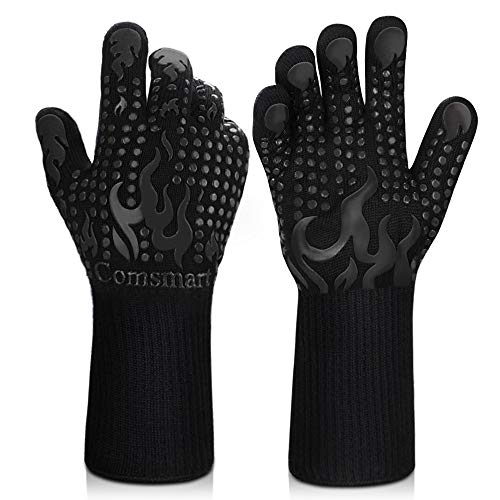When it comes to kitchen safety and efficiency, gloves play an essential role. However, with so many types of gloves available, it can be challenging to determine which ones are the best for your needs. Whether you’re seeking heat resistance, cut protection, or simply convenience, each type of glove serves a unique purpose. In this blog post, we’ll explore some of the most popular glove options for cooking, baking, and food prep, so you can make an informed decision and keep your hands safe and comfortable in the kitchen. Let’s dive in!
Table of Contents
Heat-Resistant Gloves For Safety And Comfort
There’s no better feeling than cooking up a storm in the kitchen, making a delectable dish that your family and friends will absolutely love. However, we all know that cooking, while fun, can also be dangerous. Hot pots, pans, and ovens can cause serious burns if not handled with care. That’s where heat-resistant gloves come in. These gloves are designed to protect your hands from extreme heat while cooking, ensuring your safety and comfort.
When it comes to choosing the best gloves for cooking, there are a few things to consider. First and foremost, the gloves should be made from heat-resistant materials such as silicone, neoprene, or Kevlar. These materials can withstand high temperatures without melting or deteriorating, giving you the protection you need while cooking.
If you’re looking for gloves that offer both safety and comfort, then silicone gloves may be the way to go. These gloves are versatile and can be used for a variety of kitchen tasks, from grilling to baking. The best part? They’re easy to clean and dishwasher safe, making them a convenient option for busy cooks.
| Pros of Heat-Resistant Gloves | Cons of Heat-Resistant Gloves |
|---|---|
| Heat-resistant | May be too bulky for some tasks |
| Dishwasher safe | May not be cut-proof |
| Can be used for various tasks | May not fit all hand sizes |
Another option to consider is neoprene gloves, which are known for their excellent heat resistance and durability. These gloves are often used by professional chefs and are ideal for high-temperature cooking such as frying and grilling. They also provide a good grip, which can be important when handling hot items. However, they may not be as comfortable or easy to clean as silicone gloves.
Ultimately, the best gloves for cooking depend on your personal preferences and the type of cooking you do. If you prioritize safety and comfort, then silicone gloves may be the way to go. If you need gloves for specific tasks such as frying or grilling, then neoprene gloves may be a better choice. Whatever gloves you choose, remember to always prioritize safety while cooking.
Cut-Proof Gloves For Effortless Food Prep
Cut-proof gloves are one of the best gloves for cooking that you can find in the market. They are specially designed to protect your hands while you are handling sharp knives and other kitchen tools. With these gloves, you can confidently chop, slice, and dice your ingredients without worrying about accidentally cutting yourself. Additionally, these gloves are ideal for those who are new to cooking or for those who want to speed up their food preparation process.
If you want to invest in cut-proof gloves, there are different types and materials to choose from, such as aramid fibers, stainless steel wire, and high-performance polyethylene. Aramid fibers, such as Kevlar and Nomex, are known for their durability and heat resistance. Stainless steel wire gloves are also sturdy and can be easily cleaned. High-performance polyethylene gloves, on the other hand, are lightweight and comfortable to wear.
| Pros of Cut-Proof Gloves | Cons of Cut-Proof Gloves |
| – Protects your hands from cuts and nicks – Ideal for handling sharp knives and other tools – Durable and long-lasting | – May limit your dexterity and mobility – May not fit your hands properly – May not be suitable for handling hot objects |
When choosing the best cut-proof gloves for you, it is essential to consider factors such as size, fit, comfort, durability, and cost. Make sure to read product reviews and compare different brands and materials before making a purchase. Once you have found the right gloves, you can enjoy effortless food prep and cooking without compromising your hand safety and hygiene.
Silicone Gloves For Versatility And Easy Cleaning
Silicone gloves have become popular among many home cooks and professional chefs for their versatility and ease of cleaning. These gloves are made of food-grade silicone material which is heat-resistant, waterproof and durable. They can be used to handle hot items, cold items, raw foods and even be used as oven mitts. Additionally, silicone gloves are great for outdoor cooking as they are waterproof and can protect your hands from extreme temperatures.
One of the best things about silicone gloves is their versatility. Not only can you use them for cooking, but they can be used for other tasks such as cleaning, gardening, and even pet grooming. The gloves are easy to clean and can be washed in the dishwasher or by hand. They are also non-stick, so you don’t have to worry about food getting stuck to them.
| Pros of Silicone Gloves | Cons of Silicine Gloves |
|---|---|
| – Heat-resistant – Waterproof – Durable – Non-stick – Can be washed in dishwasher | – Not cut-proof – Thick and bulky |
While silicone gloves have many advantages, they also have their disadvantages. For instance, the gloves are not cut-proof, so you still need to be careful when handling sharp objects. Also, some people may find them to be thick and bulky, which could make it difficult to handle smaller items.
Overall, silicone gloves are a great addition to any cook’s kitchen. They are versatile, easy to clean, and come in a variety of colors and styles. Whether you’re cooking indoors or outdoors, these gloves are sure to come in handy. So if you’re looking for the best gloves for cooking, consider giving silicone gloves a try.
Disposable Gloves For Convenience And Hygiene
When it comes to cooking, safety and hygiene are two of the most important things to consider. Disposable gloves have become a popular choice among chefs and home cooks alike for their convenience and ability to maintain a clean kitchen environment.
One of the best things about disposable gloves is that they can easily be disposed of after use, eliminating the need for time-consuming cleaning. They also come in various sizes, making them customizable to each individual cook’s hand size and providing a comfortable fit.
| Pros of Disposable Gloves: | Cons of Disposable Gloves: |
|---|---|
| – Convenient – Disposable – Sized for comfort – Affordable | – Can tear easily – Not heat-resistant – Not eco-friendly |
Additionally, disposable gloves are often more affordable than reusable gloves, making them a cost-effective option for those who cook often. However, it’s important to note that they are not heat-resistant and can tear easily, which may not make them the best choice for all cooking tasks.
Disposable gloves also provide an added layer of hygiene, especially when handling raw meats or other potentially contaminated ingredients. They can prevent cross-contamination and minimize the risk of foodborne illnesses. However, it’s important to remember that disposable gloves are not eco-friendly and should be disposed of properly.
When it comes to choosing the best gloves for cooking, disposable gloves can provide convenience and hygiene benefits. While they may not be the best option for all cooking tasks, they can be a great addition to any cook’s utensil collection.
Best Gloves For Cooking FAQs
Heat-resistant gloves are designed to protect your hands from high temperatures and potential burns. They are made from materials such as Kevlar and Nomex and can withstand heat up to 932°F. You should use them when working with hot foods, grilling, oven-baking or using any kitchen equipment that generates a lot of heat.
Cut-proof gloves are made from materials like stainless steel mesh or Kevlar and can withstand cuts from sharp knives and other kitchen tools. They can make food prep easier and safer by minimizing the risk of cuts and injuries while chopping, slicing, or dicing.
Silicone gloves are versatile and can be used for tasks like grilling, baking, and handling hot pots and pans. They are heat-resistant and can withstand temperatures up to 500°F. Silicone gloves offer extra grip and easy cleaning as well.
Disposable gloves are commonly used in food handling and preparation to maintain hygiene and avoid contamination. They are made of materials like latex, vinyl, or nitrile and come in different sizes. You should use them whenever handling food, changing diapers, or cleaning up after someone who is sick.
The best way to clean heat-resistant gloves is to hand wash them using soap and water. Lightly scrub them with a sponge or cloth, then rinse them thoroughly with plenty of water. Air dry them before using them again.
To choose the right size of gloves, measure around the widest part of your palm while keeping your fingers extended. Then, match your measurement to the size chart provided by the manufacturer. Make sure the gloves fit snugly but not too tight, and avoid loose-fitting gloves that may cause accidents.
Heat-resistant gloves are designed to protect your hands from high temperatures and burns. They are not recommended for use in cold temperatures because they are not insulated. For protection against the cold, you can use insulated gloves or mittens made from materials like leather, wool, or synthetic materials.

Hi, I’m Maria from Los Angles. Born and raised in a family of avid home cooks, developed a love for food at a young age. I remember spending weekends in the kitchen with her parents, learning how to make family favorites like lasagna and chocolate chip cookies. After graduating from college, started working as a marketing manager for a tech company, but I found myself spending all of her free time in the kitchen. Then I decided to share my experiences on FindForKitchen blog.













